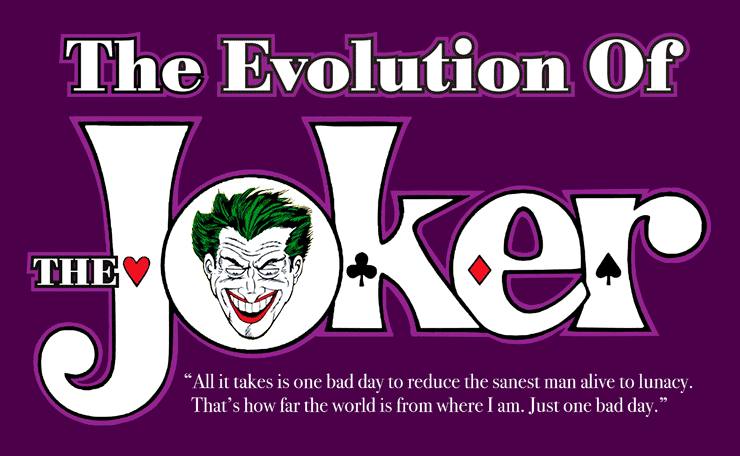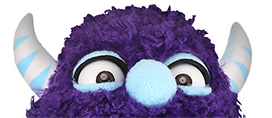2019 Update: We brought the infographic current to include Joaquin Phoenix in The Joker, and filled in many appearances since Suicide Squad.
No superhero and supervillain duo embody the eternal struggle of good and evil better than Batman and the Joker. Where Batman embodies justice, order, and all that is good, The Joker is the personification of evil, anarchy, and chaos. The Joker and Batman have been going at it since the 1940s, and will continue to do so for the foreseeable future. His origin in the real world is as mysterious as it is in the comics, with three different men claiming to have had varying degrees of responsibility in creating him. A character that was meant to be a one-off appearance eventually evolved into one of the most recognizable villains in popular culture.
Over his nearly 80 year history, the Clown Prince of Crime has appeared in cartoons, live-action television, movies, video games, and comics. Explore his inspirations and how he has changed with this awesome evolution infographic.
Click on Image for Larger View
Embed This Image on Your Site:
The Evolution of the Joker Transcript
“All it takes is one bad day to reduce the sanest man alive to lunacy. That's how far the world is from where I am. Just one bad day.” — The Joker, from Batman: The Killing Joke by writer Alan Moore and artist Brian Bolland
As one of the most recognizable faces in comics, the Joker has been terrorizing Gotham City since 1940 in Batman #1. The Clown Prince of Crime has been depicted in comics, movies, cartoon, and video games—each portrayal iconic in its own right. As we approach the Joker’s 80th anniversary, we’d like to take a walk back through time to examine the evolution of the Joker.
Steeplechase Face (1897)
Former DC Comics editorial director Carmine Infantino believes Bill Finger was the sole creator of the Joker. “Bill showed me a drawing—Bill used to go to Steeplechase out in Coney Island, Brooklyn. […] Bill went out there one time and … made a copy of that head.”
The Man Who Laughs (1928)
Batman co-creator Bob Kane’s account of the Joker’s creation differs: “Bill Finger had a book with a photograph of Conrad Veidt [the actor in The Man Who Laughs] and showed it to me and said, ‘Here’s the Joker.’ Jerry Robinson had absolutely nothing to do with it.”
Robinson’s Sketch
Series artist Jerry Robinson tells another story: “It was based on a playing card [I drew] and the character had a lot of mystery to him early on. We had no idea, of course, that we’d still be talking about him all these years later.”
Jerry Robinson (1940)
The Joker’s first appearance was supposed to be his last. The character was meant to die at the end of Batman #1. A final panel was added by the editorial decision of Whitney Ellsworth that showed the Joker surviving his supposed demise.
Dick Sprang (1943 and 1952)
Dick Sprang’s Joker reflected the more light-hearted nature of the character, emphasizing his smile and lengthening his chin. Sprang’s Joker would evolve over time, initially sporting bushy eyebrows (left), but later thinned brows and a larger smile (right).
Carmine Infantino (1964)
Infantino was brought on after successfully redesigning the Flash. He was the first Batman artist who signed his own name to his work; all artists before him were required to sign the name “Bob Kane.” His Joker took obvious cues from Sprang’s version.
Batman TV Series (1966)
Cesar Romero famously refused to shave his mustache for the role. He was often cast as a dark and handsome type and claimed his mustache was his trademark. The ‘stache is visible in close-ups of Romero’s Joker.
Filmation (1968)
The long-chinned look started by Sprang and Infantino carried over to the Filmation animated series, The Adventures of Batman. This iteration of the Joker was voiced by Larry Storch, and was accompanied by a hyena named Giggles.
Hanna-Barbera (1972)
Hanna-Barbera animated the Joker with a long hooked nose to give him a more distinct profile, a smaller mouth, and his hairstyle gave the illusion of him having pointed ears. Despite his new look, he was again voiced by Larry Storch.
Neal Adams (1973)
Adams’ Joker was a return to his more homicidal nature, and his change in temperament was accompanied by an updated style. This Joker was so thin and tall, he looked almost inhuman.
Frank Miller (1986)
In Batman: The Dark Knight Returns, Miller drew the Joker with a broader jaw and fuller face with a mouth that was not particularly large. This version of the Joker also rarely smiled.
Brian Boland (1988)
The Killing Joke is considered by many to be the definitive Joker story. When asked what writer, hero and villain he would want to do Bolland said “I basically came up with Alan [Moore], Batman and the Joker.”
Batman Movie (1989)
Nicholson said of his portrayal of the Joker, “This would be the character whose core, while totally determinant of the part, was the least limiting of any I would ever encounter.” Nicholson required 355 silicone adhesive prosthetics to give him his Joker smile.
Batman: The Animated Series (1992)
Voice director Andrea Romano said of Joker’s iconic voice actor, “You could actually videotape Mark Hamill recording the voice and use some of that for the animation, he is so articulate in his physical acting.” Hamill would go on to voice the Joker in numerous animated series and games.
The New Batman Adventures (1997)
Batman: The Animated Series character designer Bruce Timm simplified the designs in The New Batman Adventures to help animators render the characters more consistently. In the Joker’s case, much detail was removed from his face, particularly around his eyes and mouth.
Batman Beyond (2000)
Timm’s Joker in Batman Beyond: Return of the Joker combined the detailed face from Batman: The Animated Series and the pointed chin from The New Batman Adventures. The Joker’s outfit and slicked hair harkened back to the character’s original inspiration, The Man Who Laughs.
The Batman (2004)
This incarnation of the Joker differed wildly from previous iterations. Hunched shoulders, a green tongue and jester hat-like hair were all a part of his look. This Joker even came with red eyes to accent his crazier-than-usual personality.
The Dark Knight (2008)
Director Christopher Nolan said of Heath Ledger’s Joker: “We didn’t have that moment with Heath Ledger where we just sort of made him dress up as the Joker and suddenly he was the Joker, that would’ve been very artificial. And so he developed the look of the character … over a long period of time.”
Brave and the Bold (2008)
This animated series was based on The Brave and the Bold comics first published in 1955. The show had a Silver Age aesthetic similar to the 1960s live-action television series, though the Joker’s exaggerated triangle-shaped head was closer to animated television designs.
Arkham Game Series (2009)
The Arkham game series Joker took the gaunt portions of his look to new heights. This Joker was tall and skinny, with a pronounced jaw and an almost too-wide grin. Designers meant for him to be the opposite of the physically imposing Batman than they had designed.
DC Universe Online (2011)
The Joker appears as a non-playable mentor in the MMORPG as well as an unlockable player Legends Avatar. Players are also able to select templates to make their own characters appear like the Joker. Each appearance is different but they all include purple and green Joker motifs.
Greg Capullo (2012 and 2014)
Greg Capullo hadn’t realized Joker’s face had been torn off when it came time to start the “Death of the Family” arc. His solution was to have the Joker wear his face Texas Chainsaw Massacre-style. When the Joker’s face was repaired, he was given shorter hair with his familiar face.
Injustice Series (2013 and 2017)
In 2008, Mortal Kombat vs. DC Universe introduced Richard Epcar as the voice of Joker. He then had a larger role in Injustice: Gods Among Us, triggering the story within the series. The Joker returned again to Injustice 2 with an edgy look that polarized fans of the series.
Teen Titans Go! (2013)
While the Joker wasn’t a regular on the Cartoon Network series, he was referenced and made a number of comedic cameo appearances. Those references and cameos drew from a variety of Joker incarnations but they often had the animated triangular hair and head design.
Gotham (2014)
Unable to use the name “Joker”, Gotham had “Proto-Jokers” Jerome and Jeremiah Valeska, both played by Cameron Monaghan. These characters showed how a character like the Joker could come to be. Whether or not Jeremiah became (or simply inspired) the Joker was left ambiguous.
Suicide Squad (2016)
This recent cinematic take on the Joker was a stark departure from previous looks. While rumored to have used Frank Miller’s Batman: The Dark Knight Returns as a starting point, actor Jared Leto’s Joker included controversial additions such as tattoos and capped teeth.
Telltale Series (2016)
The Telltale Games series gave us a new origin story for the Joker, as unpredictable Arkham Asylum patient “John Doe”. He appears without makeup for much of the first game but his eventual Joker design was influenced by a variety of comic artists, especially Greg Capullo.
Return of the Caped Crusaders (2016)
The animated films Batman: Return of the Caped Crusaders and Batman vs. Two-Face were tributes to the original 1960s Batman television series and film. The Joker’s appearance was no different, a cartoonish version of the Cesar Romero character.
Justice League Action (2016)
Justice League Action saw a return to the familiar triangular head shape, although the Joker’s features were more exaggerated. His hair and chin were especially pointy. Mark Hamill also returned as the voice of the Joker.
The Lego Batman Movie (2017)
The second theatrical entry of the Lego Movie franchise featured a huge number of supervillains, including a more emotionally-conflicted portrayal of the Joker, voiced by Zach Galifianakis. The Joker had a traditional Lego-like appearance, with a rectangular body and cylindrical head shape.
Batman Ninja (2018)
In the anime film Batman Ninja, the Joker gets sent back in time to Feudal Japan. His appearance blended traditional Japanese daimyō elements with the usual purple and green clown outfit. He also wore a top knot and a mustache like those seen on samurai armor.
Batman vs. Teenage Mutant Ninja Turtles (2019)
Based on the 2015 comic miniseries, this animated film involves the Turtles getting sent into Batman’s dimension. The Joker has a caricature-like design from comic artist Freddie E. Williams II. Arkham Origins voice actor Troy Baker returns.
Joker (2019)
This live-action film introduces another new origin story for the Joker: stand-up comedian Arthur Fleck. Played by actor Joaquin Phoenix, Fleck appears in traditional clown makeup. The design has been compared to Heath Ledger’s Joker as well as serial killer John Wayne Gacy.
Can you believe the Joker has changed so much in the last 80(ish) years? What do you think about Jared Leto's interpretation of the character from Suicide Squad? Or the trailers for Joker with Joaquin Phoenix? Comment below with your favorite version of the Joker, and don't forget to check out our selection of Joker costumes and Batman costumes in our shop!
Infographic designed by Kate Willaert with 2016-2019 update by Brady Johnson



